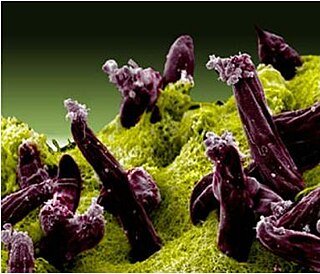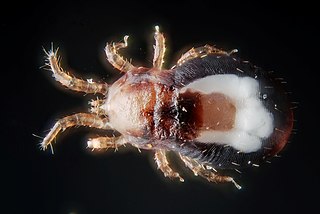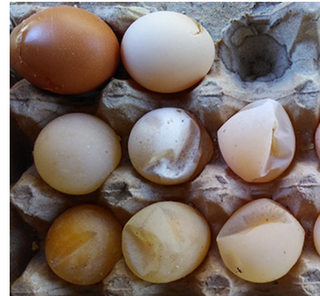Related Research Articles

Poultry are domesticated birds kept by humans for the purpose of harvesting animal products such as meat, eggs or feathers. The practice of raising poultry is known as poultry farming. These birds are most typically members of the superorder Galloanserae (fowl), especially the order Galliformes. The term also includes waterfowls of the family Anatidae but does not include wild birds hunted for food known as game or quarry.

Debeaking, beak trimming, or beak conditioning, is the partial removal of the beak of poultry, especially layer hens and turkeys, although it may also be performed on quail and ducks. Most commonly, the beak is shortened permanently, although regrowth can occur. The trimmed lower beak is somewhat longer than the upper beak. A similar but separate practice, usually performed by an avian veterinarian or an experienced birdkeeper, involves clipping, filing or sanding the beaks of captive birds for health purposes – in order to correct or temporarily to alleviate overgrowths or deformities and better allow the bird to go about its normal feeding and preening activities. Amongst raptor-keepers, this practice is commonly known as "coping".

Breed broiler is any chicken that is bred and raised specifically for meat production. Most commercial broilers reach slaughter weight between four and six weeks of age, although slower growing breeds reach slaughter weight at approximately 14 weeks of age. Typical broilers have white feathers and yellowish skin. Broiler or sometimes broiler-fryer is also used sometimes to refer specifically to younger chickens under 2.0 kilograms, as compared with the larger roasters.
Poultry diseases occur in poultry, which are domesticated birds kept for their meat, eggs or feathers. Poultry species include the chicken, turkey, duck, goose and ostrich.

Plasmodium gallinaceum is a species of the genus Plasmodium that causes malaria in poultry.
Marek's disease is a highly contagious viral neoplastic disease in chickens. It is named after József Marek, a Hungarian veterinarian who described it in 1907. Marek's disease is caused by an alphaherpesvirus known as "Marek's disease virus" (MDV) or Gallid alphaherpesvirus 2 (GaHV-2). The disease is characterized by the presence of T cell lymphoma as well as infiltration of nerves and organs by lymphocytes. Viruses related to MDV appear to be benign and can be used as vaccine strains to prevent Marek's disease. For example, the related herpesvirus found in turkeys (HVT), causes no apparent disease in the birds, and continues to be used as a vaccine strain for prevention of Marek's disease.
Histomonas meleagridis is a species of parasitic protozoan that infects a wide range of birds including chickens, turkeys, peafowl, quail and pheasants, causing infectious enterohepatitis, or histomoniasis. H. meleagridis can infect many birds, but it is most deadly in turkeys. It inhabits the lumen of cecum and parenchyma of liver, where it causes extensive necrosis. It is transmitted by another cecal parasite, the nematode Heterakis gallinarum.

Dermanyssus gallinae is a haematophagous ectoparasite of poultry. It has been implicated as a vector of several major pathogenic diseases. Despite its common names, it has a wide range of hosts including several species of wild birds and mammals, including humans, where the condition it causes is called gamasoidosis. In both size and appearance, it resembles the northern fowl mite, Ornithonyssus sylviarum.

Poultry farming is the form of animal husbandry which raises domesticated birds such as chickens, ducks, turkeys and geese to produce meat or eggs for food. Poultry – mostly chickens – are farmed in great numbers. More than 60 billion chickens are killed for consumption annually. Chickens raised for eggs are known as layers, while chickens raised for meat are called broilers.

Raillietina is a genus of tapeworms that includes helminth parasites of vertebrates, mostly of birds. The genus was named in 1920 in honour of a French veterinarian and helminthologist, Louis-Joseph Alcide Railliet. Of the 37 species recorded under the genus, Raillietina demerariensis, R. asiatica, and R. formsana are the only species reported from humans, while the rest are found in birds. R. echinobothrida, R. tetragona, and R. cesticillus are the most important species in terms of prevalence and pathogenicity among wild and domestic birds.

Histomoniasis is a commercially significant disease of poultry, particularly of chickens and turkeys, due to parasitic infection of a protozoan, Histomonas meleagridis. The protozoan is transmitted to the bird by the nematode parasite Heterakis gallinarum. H. meleagridis resides within the eggs of H. gallinarum, so birds ingest the parasites along with contaminated soil or food. Earthworms can also act as a paratenic host.
Avian orthoreovirus, also known as avian reovirus, is an orthoreovirus from the Reoviridae family. Infection causes arthritis and tenosynovitis in poultry. It can also cause respiratory disease.
Pacheco's disease is a highly infectious and acute bird disease caused by a species of herpesvirus, Psittacid alphaherpesvirus 1 (PsHV-1). All psittacine species are susceptible to Pacheco's disease, mainly those in zoological collections and aviaries in any geographic regions. Specifically, Pacheco's disease has a high occurrence rate in Amazon parrots, followed by African grey parrots, parrots, macaws, cockatoos and conures. Due to a very high mortality rate within these susceptible species, concerns are brought to companion bird markets and breeders.
Raillietina cesticillus is a parasitic tapeworm of the family Davaineidae. Sometimes called "Broad-headed tapeworm", it infects the small intestine of chicken and occasionally other birds, such as guinea fowl and turkey, which are generally in close proximity to backyard poultry. It is a relatively harmless species among intestinal cestodes in spite of a high prevalence. In fact it probably is the most common parasitic platyhelminth in modern poultry facilities throughout the world.
A chicken harvester is a machine used in poultry farming to gather chickens for slaughter.

Egg drop syndrome '76 is a viral disease that affects birds, notably chickens, ducks, geese and swans. It is characterised by a sudden drop in production of eggs as well as its eggshell quality in apparent healthy laying birds.

Avibirnavirus is a genus of viruses in family Birnaviridae. There is a single species in this genus: Infectious bursal disease virus, which infects chickens and other fowl. It causes severe inflammation of the bursa of Fabricius, and causes considerable morbidity and mortality.

Influenza A virus subtype H10N3 is a subtype of viruses that causes influenza (flu). It is mostly present in wild avian species. The first human case was reported in 2021.
The poultry microbiome is an understudied, yet extremely impactful part of the poultry industry. Poultry is defined as any avian species used for production purposes such as food or down feathers. The United States consumes more poultry, specifically broiler meat, than any other type of protein. Worldwide, poultry makes up 33% of consumed meat. This makes poultry extremely valuable and the impact of the poultry microbiome on health and production even more valuable. Antonie van Leeuwenhoek was the first to notice microbes inside animals through stool samples giving light to further research into the gut microbiome. His discovery lead to the ever evolving study of the microbiota and microbiome. The microbiota is the entirety of living organisms including bacteria, viruses, fungi, and archaea in an environment. The microbiome is the combination of the microbiota and the additional activities in that system including metabolites and chemicals in a habitat. Much of the work done to characterize the poultry microbiome has been accomplished over the past decade and was done through the use of 16s rRNA sequencing.
The breeding and raising of broiler chickens has created health and animal welfare issues, such as cardiovascular and skeletal dysfunction.
References
- ↑ Haslam, S.M.; Knowles, T.G.; Brown, S.N.; Wilkins, L.J.; Kestin, S.C.; Warriss, P.D.; Nicol, C.J. (19 Jun 2007). "Factors affecting the prevalence of foot pad dermatitis, hock burn and breast burn in broiler chicken". British Poultry Science. 48 (3): 264–275. doi:10.1080/00071660701371341. ISSN 0007-1668.
- 1 2 3 4 "Millions of store chickens suffer burns from excrement". BBC News. 29 February 2024. Retrieved 1 March 2024.
- ↑ Kaukonen, Eija; Norring, Marianna; Valros, Anna (2016-10-08). "Effect of litter quality on foot pad dermatitis, hock burns and breast blisters in broiler breeders during the production period". Avian Pathology. 45 (6): 667–673. doi:10.1080/03079457.2016.1197377. ISSN 0307-9457.
- ↑ Jacob, FG; Baracho, MS; Nääs, IA; Lima, NSD; Salgado, DD; Souza, R (September 2016). "Risk of Incidence of Hock Burn and Pododermatitis in Broilers Reared under Commercial Conditions". Revista Brasileira de Ciência Avícola. 18 (3): 357–362. doi:10.1590/1806-9061-2015-0183. hdl: 20.500.12733/1267 . ISSN 1516-635X.
- 1 2 Kwon, Byung-Yeon; Park, Jina; Kim, Da-Hye; Lee, Kyung-Woo (2024-04-05). "Assessment of Welfare Problems in Broilers: Focus on Musculoskeletal Problems Associated with Their Rapid Growth". Animals. 14 (7): 1116. doi: 10.3390/ani14071116 . ISSN 2076-2615. PMC 11011155 .
- ↑ Kjaer, J.B.; Su, G.; Nielsen, B.L.; Sørensen, P. (1 August 2006). "Foot Pad Dermatitis and Hock Burn in Broiler Chickens and Degree of Inheritance". Poultry Science. 85 (8): 1342–1348. doi:10.1093/ps/85.8.1342. ISSN 0032-5791.
- ↑ "Welfare plea over supermarket chickens". Manchester Evening News. 2005-07-25. Retrieved 2024-05-19.
- ↑ Broom, D.M.; Reefmann *, N. (Aug 2005). "Chicken welfare as indicated by lesions on carcases in supermarkets". British Poultry Science. 46 (4): 407–414. doi:10.1080/00071660500181149. ISSN 0007-1668.
- ↑ Jacob, Fg; Baracho, Ms; Nääs, Ia; Lima, Nsd; Salgado, Dd; Souza, R (Sep 2016). "Risk of Incidence of Hock Burn and Pododermatitis in Broilers Reared under Commercial Conditions". Revista Brasileira de Ciência Avícola. 18 (3): 357–362. doi:10.1590/1806-9061-2015-0183. ISSN 1516-635X.
- ↑ Bergmann, Shana; Helen, Louton; Westermaier, Christine; Wilutzky, Katharina; Bender, Andreas; Bachmeier, Josef; Erhard, Michael; Rauch, Elke (2016-09-05). "Field trial on animal-based measures for animal welfare in slow growing broilers reared under an alternative concept suitable for the German market". Berl Münch Tierärztl Wochensch (Berl Münch Tierärztl Wochensch): .–.. doi:10.2376/0005-9366-16035.
- ↑ Elson, H.A. (2015-09-01). "Poultry welfare in intensive and extensive production systems". World's Poultry Science Journal. 71 (3): 449–460. doi:10.1017/s0043933915002172. ISSN 0043-9339.
- ↑ Tainika, Brian; Şekeroğlu, Ahmet; Akyol, Ahmet; Waithaka Ng’ang’a, Zacharia (2023-04-03). "Welfare issues in broiler chickens: overview". World's Poultry Science Journal. 79 (2): 285–329. doi:10.1080/00439339.2023.2175343. ISSN 0043-9339.
- ↑ Shepherd, E.M.; Fairchild, B.D. (1 October 2010). "Footpad dermatitis in poultry". Poultry Science. 89 (10): 2043–2051. doi:10.3382/ps.2010-00770.
- ↑ Elson, H.A. (2015-09-01). "Poultry welfare in intensive and extensive production systems". World's Poultry Science Journal. 71 (3): 449–460. doi:10.1017/s0043933915002172. ISSN 0043-9339.
- ↑ Louton, H.; Piller, A.; Bergmann, S.; Erhard, M.; Stracke, J.; Spindler, B.; Kemper, N.; Schmidt, P.; Schade, B.; Boehm, B.; Kappe, E.; Bachmeier, J.; Schwarzer, A. (2020-01-23). "Histologically validated scoring system for the assessment of hock burn in broilers". Avian Pathology. 49 (3): 230–242. doi:10.1080/03079457.2020.1712328. ISSN 0307-9457.
- ↑ "Welfare Quality, Assessment Protocol for Poultry (Broilers, Laying Hens)" (guideline document). Lelystad, Netherlands: Welfare Quality consortium. January 2009. p. 26.
- ↑ Skrbic, Zdenka; Pavlovski, Z.; Lukic, M.; Peric, L.; Milosevic, N. (2009). "The effect of stocking density on certain broiler welfare parameters". Biotehnologija u stocarstvu. 25 (1–2): 11–21. doi:10.2298/bah0902011s. ISSN 1450-9156.
- ↑ Greene, Joan A.; McCracken, R.M.; Evans, R.T. (25 June 1984). "A contact dermatitis of broilers ‐clinical and pathological findings". Avian Pathology. 14 (1): 23–38. doi:10.1080/03079458508436205. ISSN 0307-9457.
- ↑ Bruce, D.W.; McIlroy, S.G.; Goodall, E.A. (19 September 1989). "Epidemiology of a contact dermatitis of broilers". Avian Pathology. 19 (3): 523–537. doi:10.1080/03079459008418705. ISSN 0307-9457.
- ↑ BESSEI, W. (1 September 2006). "Welfare of broilers: a review". World's Poultry Science Journal. 62 (03): 455. doi:10.1017/s0043933906001085. ISSN 0043-9339.